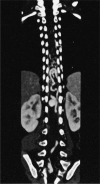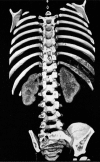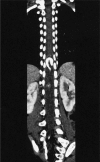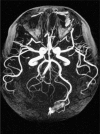Usefulness of Multidetector 3D-CT Angiography in the Evaluation of Infantile Perimedullary Spinal Arteriovenous Fistula
- PMID: 20594511
- PMCID: PMC3572521
- DOI: 10.1177/159101990200800107
Usefulness of Multidetector 3D-CT Angiography in the Evaluation of Infantile Perimedullary Spinal Arteriovenous Fistula
Abstract
We report an infantile huge perimedullary spinal arteriovenous fistula (SAVF) associated with Hereditary-Hemorrhagic-Telangiectasia (HHT), which was treated by glue embolization in one session. Three-dimensional Multidetector Computed Tomography Angiography (3D-MCTA) was useful in pre- and post-endovascular intervention.
Figures








Similar articles
-
Giant spinal perimedullary fistula in hereditary haemorrhagic telangiectasia: diagnosis, endovascular treatment and review of the literature.Neuroradiology. 2003 Nov;45(11):830-6. doi: 10.1007/s00234-003-1044-7. Epub 2003 Oct 14. Neuroradiology. 2003. PMID: 14557903 Review.
-
Acute thrombosis of a giant perimedullary arteriovenous fistula in a pediatric HHT patient.Interv Neuroradiol. 2022 Apr;28(2):132-135. doi: 10.1177/15910199211022499. Epub 2021 May 29. Interv Neuroradiol. 2022. PMID: 34053318 Free PMC article.
-
Endovascular treatment of spinal arteriovenous fistula in a young child with hereditary hemorrhagic telangiectasia. Case report.J Neurosurg. 2005 Nov;103(5 Suppl):462-5. doi: 10.3171/ped.2005.103.5.0462. J Neurosurg. 2005. PMID: 16302622
-
Spinal cord arteriovenous malformations in two patients with hereditary hemorrhagic telangiectasia.Childs Nerv Syst. 1999 Mar;15(2-3):80-3. doi: 10.1007/s003810050336. Childs Nerv Syst. 1999. PMID: 10230660
-
Spinal giant intradural perimedullary arteriovenous fistula: clinical and neuroradiological study in one case with review of literature.Surg Neurol. 1996 Jun;45(6):524-31; discussion 531-2. doi: 10.1016/0090-3019(95)00433-5. Surg Neurol. 1996. PMID: 8638237 Review.
Cited by
-
Pediatric high-flow, cervical spinal, macro-arteriovenous fistula, treated with the endovascular cotton candy glue injection technique.Childs Nerv Syst. 2010 Nov;26(11):1633-8. doi: 10.1007/s00381-010-1181-3. Epub 2010 Jun 3. Childs Nerv Syst. 2010. PMID: 20521056
References
-
- Terae K, Miyasaka K, et al. Three-dimensional reconstructed CT angiography. Detection of the Adamkiewicz artery. Abstract; 30th Japanese Neuroradiological congress; 18-22 March, 2006; Osaka, Japan. 2001.
-
- Lasjaunias P, TerBrugge K. Spinal Arteriovenous Malformation. Vascular Disease in Neonates, Infants and Children. New York; Tokyo: Springer Berlin Heidelberg; 1997. pp. 565–591.
-
- Berenstein A, Lasjaunias P. Surgical Neuroangiography. Vol. 5. Berlin Heidelberg; New York; Tokyo: Springer; 1992. Endovascular treatment of spine and spinal cord lesions.
-
- Halbach VV, Higashida R, et al. Treatment of giant intradural perimedullary arteriovenous fistulas. Neurosurgery. 1993;33(6):972–984. - PubMed
-
- Rodesch G, Pongpech S, et al. Spinal Cord Arteriovenous Malformations in a Pediatric Population of Children below 15 Years of Age. The place of Endovascular management. Interventional Neuroradiology. 1995;1:29–42. - PubMed
LinkOut - more resources
Full Text Sources

